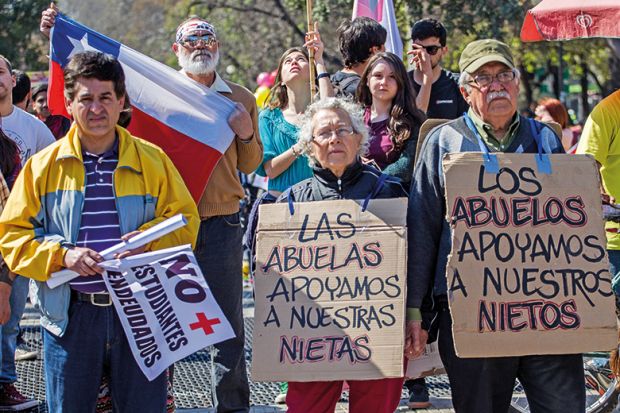Browse the full results of the Latin America University Rankings 2017
By all measures, Latin American policymakers have been under significant pressure to respond to the increasing demand for higher education in the region. The rise of democracy, the return of economic stability and the pressing need to develop higher education systems fit for the global knowledge economy have been forcing policymakers to rethink, refund and reform higher education.
Chile is at the forefront of these efforts. It recently took an extremely controversial step towards higher education reform – increasing taxes to fund free higher education for the poorest students. This is quite a turn in a country whose economic model is market driven and whose higher education system is among the most privatised and expensive in the world. For example, Chilean families contribute at least 75 per cent of all higher education costs; the government contributes only the remaining 25 per cent. That is one of the highest rates of private contribution to higher education anywhere – even among other countries of the Organisation for Economic Cooperation and Development.
At the centre of this new policy is the promise made by Michelle Bachelet (pictured, inset), the country’s president, to deliver “free higher education for all” – or “gratuidad para todos”. Yet not a single political group in the country supports the measure. Not the main student organisations on the Left, which have been advocating and protesting for years to achieve this goal and which now complain that the programme is confusing, does not provide enough funding to cover all expenses, and simply eliminates existing scholarship programmes and replaces them with a new scheme. Not the bankers and the student loan providers, which have seen their revenues dwindle as a result of recent reforms. And especially not the private and public universities, which now have to implement the new policy and stand to lose significant amounts of revenue. This can mean only one thing: Bachelet got it just right.
While it is possible to criticise the new policy as insufficient, unsustainable and even counterproductive to a free-market economy, it is also possible to see the potential for this experiment to show the way forward in Latin America. First of all, given the significant economic interests tied to the private higher education market in Chile, it stands to reason that this programme poses a significant threat to bankers whose long-term revenues, in the form of interest collected from student loans, will be reduced by the introduction of reform. They had already taken a hit when interest rates were lowered in 2011 by Sebastián Piñero, who was president then, in response to massive student demonstrations. Long-term student loan debt only contributes to already unacceptably high levels of income inequality in Chile and elsewhere in Latin America, so a combination of lower interest rates and low to no debt introduces a new model that begins to spread the cost of financing higher education across various groups – and such a system could be more sustainable in the long term.
Download a copy of the Latin America University Rankings 2017 digital supplement
The reform also poses a challenge to university administrators in Chile, who had become accustomed to dealing with any threats to their income stream by increasing tuition fees. Regardless of their designation, Chilean universities are premised on a self-funded model that depends on the continuing rise of tuition fees. This can only mean that over time, unless income inequality decreases significantly and the economy is able to maintain a high rate of growth (above 5 per cent a year), rising tuition costs threaten to exacerbate already high levels of inequality. Hence, it will be difficult for university administrators, particularly those in the private sector, which comprises more than 80 per cent of all higher education enrolments, to continue relying on raising tuition charges to solve budget problems. The reform addresses this issue indirectly by reducing the pressure to increase tuition charges and thus guaranteeing a steady income stream to all universities.
This new model also poses an existential threat to the student organisations that effectively mobilised students and their families to gain significant political clout. While student organisations and their former leaders, some of whom are now elected members of Congress, have raised important concerns about the effectiveness, fairness and financial sustainability of this reform, they seem unaware of their victory. That is, the Bachelet administration took one of their central demands – to provide free higher education to students in the lowest three quintiles of income – and turned it into reality.
It is no wonder, then, that the only people cheering this reform are the very students who are now able to attend university and can focus on their studies rather than agonise over how they will pay for it. Paradoxically, the fate of this reform seems doomed. It works well – too well.
J. Salvador Peralta, associate professor and chair of the political science department at the University of West Georgia.




